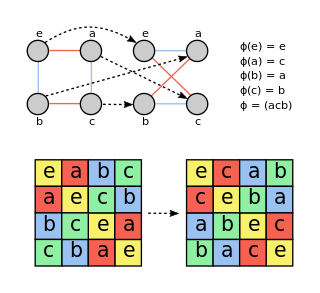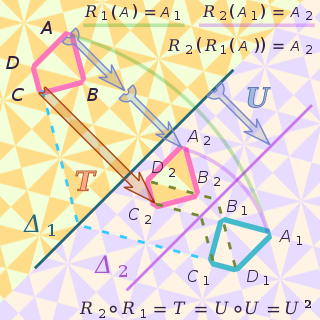
In mathematics, an automorphism is an isomorphism from a mathematical object to itself. It is, in some sense, a symmetry of the object, and a way of mapping the object to itself while preserving all of its structure. The set of all automorphisms of an object forms a group, called the automorphism group. It is, loosely speaking, the symmetry group of the object.

In mathematics and more specifically in topology, a homeomorphism, also called topological isomorphism, or bicontinuous function, is a bijective and continuous function between topological spaces that has a continuous inverse function. Homeomorphisms are the isomorphisms in the category of topological spaces—that is, they are the mappings that preserve all the topological properties of a given space. Two spaces with a homeomorphism between them are called homeomorphic, and from a topological viewpoint they are the same.

In mathematics, an isomorphism is a structure-preserving mapping between two structures of the same type that can be reversed by an inverse mapping. Two mathematical structures are isomorphic if an isomorphism exists between them. The word is derived from Ancient Greek ἴσος (isos) 'equal' and μορφή (morphe) 'form, shape'.

In mathematics, a metric space is a set together with a notion of distance between its elements, usually called points. The distance is measured by a function called a metric or distance function. Metric spaces are the most general setting for studying many of the concepts of mathematical analysis and geometry.
This is a glossary of some terms used in the branch of mathematics known as topology. Although there is no absolute distinction between different areas of topology, the focus here is on general topology. The following definitions are also fundamental to algebraic topology, differential topology and geometric topology. For a list of terms specific to algebraic topology, see Glossary of algebraic topology.
In the mathematical field of topology, a uniform space is a set with additional structure that is used to define uniform properties, such as completeness, uniform continuity and uniform convergence. Uniform spaces generalize metric spaces and topological groups, but the concept is designed to formulate the weakest axioms needed for most proofs in analysis.

In mathematics, topological groups are the combination of groups and topological spaces, i.e. they are groups and topological spaces at the same time, such that the continuity condition for the group operations connects these two structures together and consequently they are not independent from each other.
In mathematics, a topological vector space is one of the basic structures investigated in functional analysis. A topological vector space is a vector space that is also a topological space with the property that the vector space operations are also continuous functions. Such a topology is called a vector topology and every topological vector space has a uniform topological structure, allowing a notion of uniform convergence and completeness. Some authors also require that the space is a Hausdorff space. One of the most widely studied categories of TVSs are locally convex topological vector spaces. This article focuses on TVSs that are not necessarily locally convex. Other well-known examples of TVSs include Banach spaces, Hilbert spaces and Sobolev spaces.

In mathematics, general topology is the branch of topology that deals with the basic set-theoretic definitions and constructions used in topology. It is the foundation of most other branches of topology, including differential topology, geometric topology, and algebraic topology.
In the area of mathematics known as functional analysis, a reflexive space is a locally convex topological vector space for which the canonical evaluation map from into its bidual is a homeomorphism. A normed space is reflexive if and only if this canonical evaluation map is surjective, in which case this evaluation map is an isometric isomorphism and the normed space is a Banach space. Those spaces for which the canonical evaluation map is surjective are called semi-reflexive spaces.

In topology, two continuous functions from one topological space to another are called homotopic if one can be "continuously deformed" into the other, such a deformation being called a homotopy between the two functions. A notable use of homotopy is the definition of homotopy groups and cohomotopy groups, important invariants in algebraic topology.

In mathematics, an isometry is a distance-preserving transformation between metric spaces, usually assumed to be bijective. The word isometry is derived from the Ancient Greek: ἴσος isos meaning "equal", and μέτρον metron meaning "measure". If the transformation is from a metric space to itself, it is a kind of geometric transformation known as a motion.
In mathematics, the category of topological spaces, often denoted Top, is the category whose objects are topological spaces and whose morphisms are continuous maps. This is a category because the composition of two continuous maps is again continuous, and the identity function is continuous. The study of Top and of properties of topological spaces using the techniques of category theory is known as categorical topology.
In mathematics, more specifically differential topology, a local diffeomorphism is intuitively a map between smooth manifolds that preserves the local differentiable structure. The formal definition of a local diffeomorphism is given below.

In mathematics, a space is a set endowed with a structure defining the relationships among the elements of the set. A subspace is a subset of the parent space which retains the same structure. While modern mathematics uses many types of spaces, such as Euclidean spaces, linear spaces, topological spaces, Hilbert spaces, or probability spaces, it does not define the notion of "space" itself.
In mathematics, especially in algebraic topology, an induced homomorphism is a homomorphism derived in a canonical way from another map. For example, a continuous map from a topological space X to a topological space Y induces a group homomorphism from the fundamental group of X to the fundamental group of Y.
In mathematics, a morphism is a concept of category theory that generalizes structure-preserving maps such as homomorphism between algebraic structures, functions from a set to another set, and continuous functions between topological spaces. Although many examples of morphisms are structure-preserving maps, morphisms need not to be maps, but they can be composed in a way that is similar to function composition.
In mathematics, equivalent definitions are used in two somewhat different ways. First, within a particular mathematical theory, a notion may have more than one definition. These definitions are equivalent in the context of a given mathematical structure. Second, a mathematical structure may have more than one definition.
In the branch of mathematics called functional analysis, a complemented subspace of a topological vector space is a vector subspace for which there exists some other vector subspace of called its (topological) complement in , such that is the direct sum in the category of topological vector spaces. Formally, topological direct sums strengthen the algebraic direct sum by requiring certain maps be continuous; the result retains many nice properties from the operation of direct sum in finite-dimensional vector spaces.
F. Riesz's theorem is an important theorem in functional analysis that states that a Hausdorff topological vector space (TVS) is finite-dimensional if and only if it is locally compact. The theorem and its consequences are used ubiquitously in functional analysis, often used without being explicitly mentioned.
















